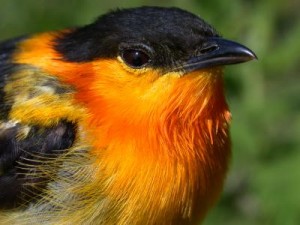There are various certifications to look for when you want healthy organic coffee. We have written about USDA certification and certification by the Rainforest Alliance and UTZ. And we have written about shade grown coffee. The Smithsonian Migratory Bird Center has come out with a certification for Bird Friendly Coffee!
The Smithsonian Migratory Bird Center has developed the only 100% organic and shade-grown coffee certification available: Bird Friendly.
That’s right-no other bag guarantees that every bean is produced organically and under high-quality shade. Our seal of approval ensures tropical “agroforests” are preserved and migratory birds find a healthy haven when they travel from your backyard to those faraway farms producing the beans you so enjoy every morning.
Bird friendly coffee comes from coffee plantations with a variety of shade trees and not just a monoculture on one kind. The Smithsonian requires native trees appropriate for native birds. But, what makes bird friend coffee so great?
Shade Grown Coffee
Growing coffee in the shade is nature’s way of growing coffee.
Growing organic coffee in the shade is how growers follow the traditional means of growing coffee. Coffee is grown in the tropics and traditionally grows on the sides of hills and mountains. The time honored means of planting is to put 20 seeds in a hole of which about half survive to grow into coffee bushes. Traditional planting takes place at the start of the rainy season. It takes several years for coffee to mature and start producing coffee beans. Thus traditional growers often plant other crops amount the coffee while it is maturing. Today most growers follow the example set in Brazil of growing seedlings in a greenhouse and then planting outside when they are ready. Growing organic coffee in the shade is done by two methods. One is to partially clear forest and plant coffee. The other is to plant trees among the coffee in order to provide shade. When fruit trees are used the coffee grower enjoys two crops on the same land.
And when trees are left in place the result is bird friendly coffee. Most experts agree that shade grown coffee is better coffee, more flavorful and mild. But the best part of shade grown coffee is preservation of the environment. This method of growing coffee protects the soil, the water table and the plants. Because plants are not bunched together they are less likely to be infested by insects or plant diseases. This removes the need to use powerful insecticides and pesticides so that the end result is organic shade grown coffee. And not using insecticides and fungicides also results in healthier birds!
Which Birds Are We Talking About?
Here is a list of the birds that inhabit or migrate to tropical and semitropical coffee plantations and are primary beneficiaries of bird friendly coffee growing, courtesy of Audubon.
- Sharp-shinned Hawk
- Broad-winged Hawk
- American Kestrel
- Lesser Nighthawk
- Ruby-throated Hummingbird
- Yellow-bellied Flycatcher
- Traill’s (Willow and Alder) Flycatcher
- Least Flycatcher
- Hammond’s Flycatcher
- Brown-crested Flycatcher
- Sulphur-bellied Flycatcher
- Western Kingbird
- Yellow-throated Vireo
- Blue-headed Vireo
- Warbling Vireo
- Red-eyed Vireo
- Yellow-green Vireo
- Violet-green Swallow
- Cliff Swallow
- Barn Swallow
- Blue-gray Gnatcatcher
- Swainson’s Thrush
- Wood Thrush
- Golden-winged Warbler
- Tennessee Warbler
- Nashville Warbler
- Northern Parula
- Yellow Warbler
- Magnolia Warbler
- Golden-cheeked Warbler
- Black-throated Green Warbler
- Townsend’s Warbler
- Blackburnian Warbler
- Black-and-white Warbler
- American Redstart
- Worm-eating Warbler
- Ovenbird
- Louisiana Waterthrush
- Kentucky Warbler
- Mourning Warbler
- MacGillivray’s Warbler
- Hooded Warbler
- Wilson’s Warbler
- Canada Warbler
- Yellow-breasted Chat
- Summer Tanager
- Western Tanager
- Rose-breasted Grosbeak
- Indigo Bunting
- Painted Bunting
- Orchard Oriole
- Baltimore Oriole
